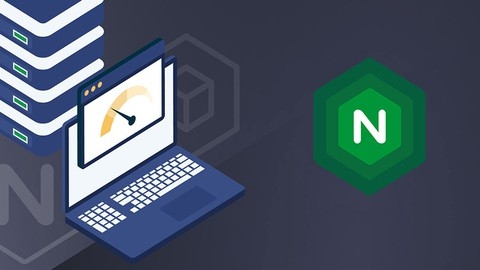NGINX Fundamentals: High Performance Servers from Scratch
The course starts by explaining NGINX’s background and how it differs from the widely-used Apache web server in terms of performance, memory usage, server-side language configuration, and URI handling.
You’ll learn about the motivations behind NGINX’s design and its core architecture.
Next, you’ll dive into installing NGINX from various sources, including package managers like apt-get and yum, as well as building it from source code.
This allows you to customize your NGINX installation by adding non-default modules.
The course also covers setting up NGINX as a system service for easier management.
A significant portion is dedicated to configuring NGINX.
You’ll learn about essential concepts like virtual hosts, location blocks, variables, rewrites, redirects, try_files, logging, and more.
The course explains how to configure NGINX for processing server-side languages like PHP using FastCGI.
You’ll also learn to optimize worker processes, buffers, and timeouts for better performance.
Performance optimization is a key focus, with lessons on configuring resource-specific Expires headers, enabling gzip compression, implementing FastCGI caching, and setting up HTTP/2 and server push.
These techniques can significantly improve client-side performance and reduce server load.
Security is another important aspect covered, including configuring SSL/TLS, rate limiting, basic authentication, and general hardening practices.
The course even includes a supplementary lesson on obtaining free SSL certificates from Let’s Encrypt.
Additionally, you’ll learn how to use NGINX as a reverse proxy and load balancer, enabling you to distribute traffic across multiple servers.
The course covers different load balancing algorithms like round-robin, IP hashing, and connection-based balancing.
Throughout the course, you’ll have access to a demo server, file transfer clients, and a terminal and editor for hands-on practice.
Quizzes are included to test your knowledge at the end of each major section.
Introduction to NGINX
You’ll start by learning the basics of what NGINX is, its use cases, and how it handles load balancing at different layers.
The course dives into NGINX’s internal architecture, threading models, and connection handling mechanisms.
The syllabus then shifts gears to practical applications, guiding you through running NGINX in Docker containers and configuring different setups.
You’ll learn about crucial NGINX timeouts on both the frontend and backend sides, which can significantly impact efficiency when configured properly.
Moving forward, you’ll explore more advanced NGINX configurations with hands-on examples, including setting it up as a web server, layer 7 proxy, and layer 4 proxy.
The course covers enabling HTTPS, TLS 1.3, and HTTP/2 on NGINX as well.
One standout section focuses on scaling WebSockets with NGINX, a tricky protocol for proxying and load balancing.
You’ll learn the fundamentals of WebSockets, the differences between layer 4 and layer 7 proxying, and how to configure NGINX for each approach.
The course wraps up by answering common questions about scaling NGINX and determining the optimal number of backend servers.
Bonus content includes articles on NGINX-related topics like reverse proxies and the limitations that led Cloudflare to build their own proxy.
The inclusion of Docker, WebSockets, and scaling strategies makes it a valuable resource for those looking to master NGINX in modern web development environments.
NGINX, Apache, SSL Encryption - Certification Course
You’ll start by deploying a virtual server on Digital Ocean and configuring Apache.
You’ll install MySQL, PHP, and PhpMyAdmin for database management.
Along the way, you’ll learn about virtual hosts, directory structures, permissions, and configuring name servers and DNS zone files.
Crucially, you’ll also learn how to install SSL certificates using Let’s Encrypt for secure connections.
The course then dives into NGINX, exploring its history and advantages over Apache.
You’ll set up NGINX from scratch, configuring it with MySQL, PHP, and PhpMyAdmin.
You’ll update DNS settings, enable authentication gateways, and even install and configure WordPress on your NGINX server.
But the real value comes from the in-depth coverage of SSL certificates.
You’ll learn the differences between traditional and digital certificates, how they work under the hood, and how to obtain and configure them.
The practice project on Digital Ocean will have you creating droplets, installing the LAMP stack, configuring DNS, and implementing Let’s Encrypt SSL certificates.
The hands-on approach ensures you gain practical experience in deploying secure, high-performance web servers.
Nginx - Beginner to Advanced
The course starts by introducing you to Nginx and guiding you through the installation process on different platforms.
You’ll learn about the HTTP protocol in-depth, including its various methods like GET, POST, and HEAD, as well as response status codes.
From there, you’ll dive into the core functionality of Nginx, understanding its architecture and configuration contexts.
The syllabus covers setting up Nginx as a reverse proxy and load balancer, two crucial use cases.
You’ll learn about active and passive health checks, traffic distribution methods like server weight and least connection.
The course also delves into the caching subsystem of Nginx, covering cache control headers, expiration headers, and keep-alive connections.
You’ll learn how to configure static asset serving and implement access control mechanisms like whitelisting, basic authentication, and even GeoIP-based restrictions.
Logging is an essential aspect covered, with lessons on access and error logs, including custom log formats.
HTTP compression with Gzip is also included to optimize content delivery.
The modular architecture of Nginx is explored in-depth, teaching you how to compile Nginx from source and build dynamic and static modules.
The syllabus even touches on setting up a Web Application Firewall (WAF) with Nginx.
Cryptography is a significant topic, covering asymmetric key encryption, HTTPS protocol, SSL/TLS configuration, and integration with Let’s Encrypt for free SSL certificates.
You’ll also learn about certificate revocation using CRL and OCSP.
Throughout the course, you’ll find practical examples and documentation to reinforce the concepts.
NGINX Web Server from Scratch
You’ll start with an introduction to NGINX, one of the most popular web servers out there.
After learning the basics, you’ll dive into installing it on Ubuntu and setting up a basic website.
But that’s just the beginning!
The course covers hosting multiple sites on a single server and configuring NGINX as a load balancer to distribute traffic efficiently.
You’ll also learn how to limit HTTP bandwidth and integrate NGINX with PHP and MySQL for dynamic websites.
Setting up WordPress is a breeze with WP-CLI, a command-line tool covered in-depth.
You’ll install WordPress using WP-CLI and manage plugins/themes from the terminal.
Security is paramount, so you’ll configure SSL certificates for secure connections and password-protect directories.
The course even teaches you to allow/deny access based on IP addresses.
Automating repetitive tasks, monitoring log files with Ngxtop, and exposing your local server to the internet using Ngrok are some handy tweaks you’ll pick up.
Customization is key, and you’ll learn to configure custom log formats and error pages to tailor NGINX to your needs.
Performance testing with ApacheBench ensures your server is up to the task.
And if you’re a WordPress user, you’ll protect against brute-force login attempts with Fail2Ban and migrate your localhost site to a live server.
Learning NGINX Web Server from Zero to Hero
You’ll start by understanding what NGINX is and how it compares to Apache, another widely-used web server.
The course guides you through setting up a sandbox environment using VirtualBox and Vagrant, ensuring you have a safe space to practice.
Once the setup is complete, you’ll dive into installing NGINX on Ubuntu step-by-step.
You’ll explore NGINX’s files, directories, and the command-line interface, giving you a solid foundation to work with.
Configuring virtual hosts is a crucial aspect, and the course dedicates two lectures to walk you through this process.
You’ll also learn how to add files to the root directory, configure locations, and set up logging for troubleshooting purposes.
Moving forward, the course introduces you to the LEMP stack (Linux, NGINX, MariaDB, and PHP).
You’ll install PHP and MariaDB on your NGINX server, followed by a hands-on demo to solidify your understanding.
Security is a top priority, and the course covers securing your NGINX sites with HTTPS, SSL certificates, password authentication, and configuring allow/deny directives.
You’ll even learn how to create a custom 403 (Forbidden) page.
One of the standout features of NGINX is its ability to act as a reverse proxy and load balancer.
The course explains the differences between these two concepts and provides live demos to help you grasp them better.
Finally, you’ll receive a comprehensive lecture on installing NGINX on Ubuntu 18 LTS, ensuring you’re well-prepared to set up your own NGINX server from scratch.
NGINX MasterClass: NGINX Server & Custom Load Balancer- 2024
This comprehensive course starts with an introduction to NGINX, its origins, and how it compares to Apache as a web server.
You’ll learn about different protocols and dive deep into the HTTP protocol’s working model, requests, and response codes.
The course then guides you through installing NGINX on Ubuntu and CentOS machines, both via package managers and by building from source code.
You’ll also learn how to add NGINX as a service in the operating system.
Once the installation is covered, you’ll explore NGINX’s configuration terminology and applications.
Through hands-on labs, you’ll learn to load static data, create virtual hosts, use location blocks, work with variables, rewrite and return directives, try_files, logging, handle dynamic requests, optimize performance, and add custom modules.
Moving on, you’ll configure NGINX as a reverse proxy and learn about the X-Real-IP directive.
The course also covers performance management techniques like client-side caching, Gzip compression, and micro-caching.
Security is a crucial aspect, and you’ll learn to enable secure HTTPS connections, HTTP/2 protocol, and prevent DDoS attacks by limiting services.
One of the key highlights is learning to use NGINX as a load balancer.
You’ll start with a simple load balancer setup and then explore default, passive, and active health checks.
The course also covers HTTP caching in-depth, including cache control headers and verifying cache file modifications on the server.
Finally, you’ll learn about access control in NGINX, allowing or restricting IP addresses, and limiting access to resources.
The Perfect Nginx Server - Ubuntu (22.04) Edition
The course starts with an introduction to Linux essentials, teaching you the necessary commands and processes to navigate the terminal, manage files and directories, and understand users and permissions.
This “Crash Course” section ensures you have the foundational knowledge required for the rest of the course.
Next, you’ll learn how to install and configure the LEMP stack (Nginx, MariaDB, and PHP 8.1) on your server.
The instructor guides you through hardening and optimizing each component for performance and security, including techniques like configuring Nginx directives, tuning MariaDB with MySQLTuner, and setting up PHP-FPM correctly.
The course covers crucial topics like server mail configuration, understanding Nginx configuration files, creating server blocks, and installing and hardening WordPress.
You’ll learn how to implement SSL/TLS certificates, configure HTTP response headers, and protect your site from various attacks, such as brute-force attempts, DDoS, and hotlinking.
Performance optimization is a significant focus, with sections dedicated to caching strategies (including FastCGI caching and W3 Total Cache with Redis), configuring Cloudflare, and tuning PHP-FPM based on your server resources.
The instructor also covers essential tasks like server updates, antivirus and malware scanning, WordPress updates, database tuning, site monitoring, and backups.
Advanced topics like creating a Content Security Policy, log rotation, and Nginx DDoS protection are also covered.
Finally, you’ll learn how to host multiple sites on a single server, using both domain names and subdomains.
Throughout the course, the instructor emphasizes the importance of hardening and optimization, providing step-by-step guidance and best practices for securing and optimizing your Nginx server and WordPress sites.
The course is designed to be hands-on, with practical examples and exercises to reinforce the concepts.
The Perfect NGINX Server - CentOS Edition
The course starts by introducing the required software and server specifications.
You’ll learn essential Linux skills like navigating the file system, managing users and permissions, and using package managers.
This lays a solid foundation for the rest of the course.
Next, you’ll dive into the initial server configuration and security hardening process.
This crucial step involves securing the server as both the root and non-root user, implementing SSH key authentication, configuring the firewall with firewalld, and setting up Fail2ban for intrusion prevention.
Security is given utmost importance throughout the course.
Once the server is hardened, you’ll install, secure, and optimize NGINX, MariaDB (a MySQL alternative), and PHP.
You’ll learn to configure NGINX’s structure, organize and optimize its main configuration file, create site directories, and set up server blocks for your WordPress sites.
Securing your WordPress installations is a dedicated section, covering various techniques like command line, SELinux, and NGINX directives.
You’ll also learn to implement SSL/TLS certificates using Let’s Encrypt and configure a Content Security Policy (CSP) for an additional security layer.
The course then dives into optimizing WordPress performance using techniques like caching (with W3 Total Cache and Redis), NGINX FastCGI caching, and integrating with Cloudflare.
You’ll learn to add additional WordPress sites effortlessly and automate essential tasks like updates and database optimization.
Backups and restoring sites (both manually and automated) are covered in detail, ensuring you can safeguard your data.
You’ll also learn how to move sites between servers and use FileZilla for file transfers.
Throughout the course, you’ll administer your WordPress sites using the powerful WP-CLI (WordPress Command Line Interface).
The course recommends a minimal set of plugins to keep your sites running smoothly.
Learn Nginx By Example
You’ll start by setting up your environment, whether it’s a Virtual Private Server (VPS) on Digital Ocean or a local Ubuntu installation using Virtual Box.
The course wastes no time diving into the core concepts of Nginx.
You’ll learn about its folder layout, the crucial sites directory, and how to install PHP and Composer for working with applications like Symfony.
But the real value lies in the extensive examples section, where you’ll get hands-on experience with real-world use cases.
From creating holding and maintenance pages to setting up error pages and a simple Content Delivery Network (CDN), you’ll master the art of configuring Nginx for various scenarios.
The examples don’t stop there.
You’ll learn how to set up FastCGI for running PHP applications, including a Symfony project.
The course even covers advanced topics like HTTPS termination, load balancing across multiple servers, and securely moving servers for HTTP and HTTPS traffic.
Security is a top priority, with an example dedicated to blocking traffic from specific countries.
Throughout the course, you’ll work with essential technologies like SSH keys, URL overriding, and HTTP/HTTPS protocols.
The syllabus is well-structured, guiding you through the setup, snippets, and examples before concluding with a bonus lecture.










